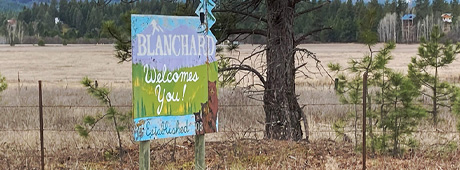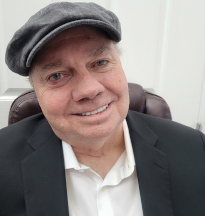No products in the cart.
Blanchard—Spotlight City

“Don’t Try to Change Us”
Story by Bob Johnson
Photos by Michelle Johnson
At first sight last March, the timeshare golf resort at tiny Blanchard in northern Idaho reminded me of Lake Tahoe on the borders of California and Nevada. “Only here, there’s not a casino in sight,” I mentioned to my wife, Michelle, as we navigated the two-lane road.
The Tahoe reference was to the thick stands of towering trees bordering the narrow road that led to the resort. Every so often, we’d come upon an unmarked driveway, which was our cue to turn our heads and spy a chalet-like home perched on a rise. And just like in Tahoe during high season when the ski resorts are packed, the A-frame rooftops were covered with snow.
When we reached the Blanchard resort’s entrance, we parked and decided to walk around. We picked up some literature and learned that the four condominium buildings contain 150 suites. There’s also a recreation center with an indoor pool and fitness center. Other facilities include tennis and pickleball courts, a Panhandle-themed miniature golf course, and a small bar and restaurant.
“It’s almost like there are two Blanchards,” Michelle observed.
Blanchard is neither a city, town, nor village. I suppose you can choose your own synonym for an area where people live in proximity to one another but, officially, it’s a “census-designated place” in Bonner County. It’s located six-a-half miles northwest of Spirit Lake, the community my family is settling in, if we survive the Kootenai County permitting process with our sanity intact. Adjacent to Idaho State Highway 41, Blanchard is about thirty miles southwest of Sandpoint and twenty miles west of Lake Pend Oreille. As of 2023, it was home to 625 people, up from 438 the previous year.
As we drove around the resort complex, which also contains an RV park, I was struck that all of it was on paved roads. This made me wonder what other folks think about this—the ones who must traverse the dirt roads near Highway 41 cratered with potholes from the waning winter. Virtually all of Blanchard’s other roads are unpaved. Do people hold any animosity toward the golf community?
I found the answer in a conversation with Julie Founds, a lifelong resident of Blanchard. She’s a long-time member of Blanchard Grange 440, a throwback to the Grange Halls that were established after the Civil War to serve America’s rural and agricultural communities.
We met at the Grange, a small wooden building painted bright white with brown trim. I thought she might be a good person to talk to about the lavish golf community considering she is one of the driving forces behind the local food bank, which the Grange houses.
“There was a lot of animosity at first,” Julie said, “but we’re a long way down the road now.”
I had learned that the original golf course opened in 1968.
“There might still be some divide between that community and the rest of the residents, but it’s not like it was at first.” She paused, and then added, “I know only three people from there. They come to the Grange and volunteer, and they’re really nice people.”
This content is available for purchase. Please select from available options.
Purchase Only
Purchase Only

